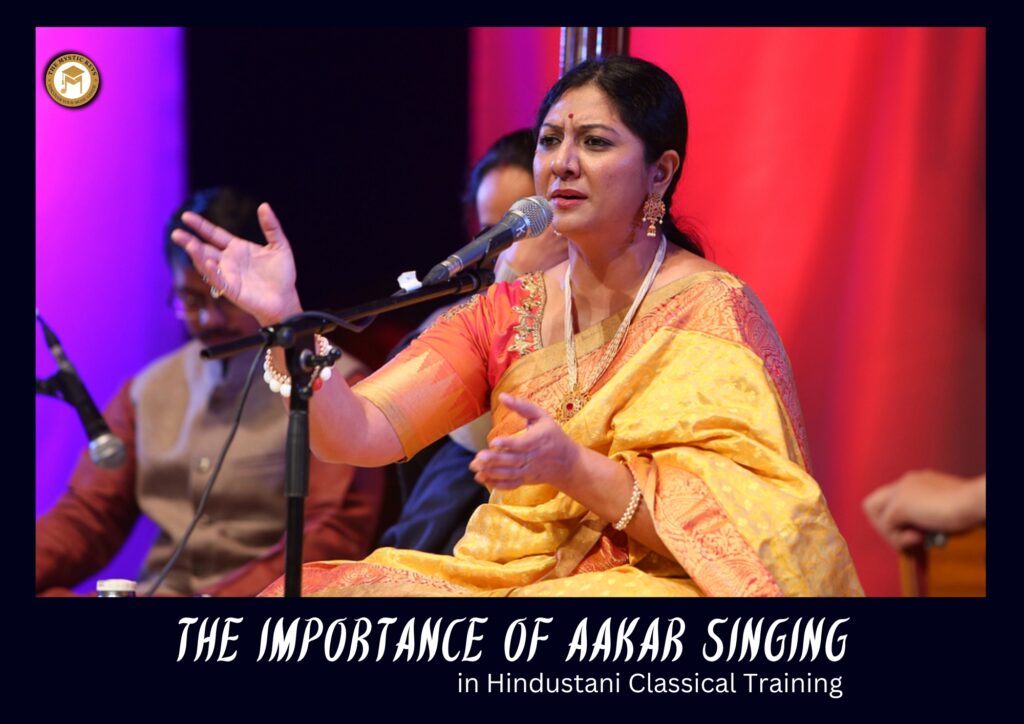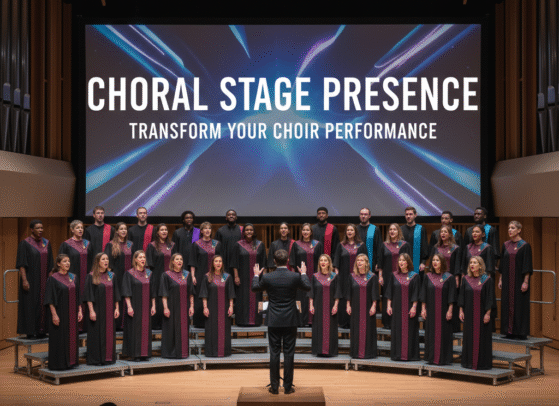The Importance of Aakar Singing in Hindustani Classical Training
Hindustani classical music is an ancient and refined tradition passed down through generations. Over time, it has evolved gracefully, shaped by legendary maestros and enriched by deep cultural roots. At its very core lies vocal music—a powerful medium for emotional expression and storytelling. Within this vocal tradition, one practice holds particular importance: Aakar singing. As a starting point for most students, it forms the bedrock of classical vocal training. Through Aakar, learners gradually build tone quality, improve breath control, and gain command over pitch. More importantly, this technique allows the voice to become more flexible, expressive, and resonant. As a result, singers are better equipped to explore the intricate nuances of raga and deliver performances that are both technically sound and emotionally moving.
Within this vocal tradition, students must master several essential techniques. Among them, Aakar singing stands out as both foundational and transformative. It forms the starting point for developing vocal strength, clarity, and emotional expression.
As we move forward, we’ll explore why Aakar holds such importance in classical training. Not only does it shape vocal skills, but it also strengthens raga performance, refines breath control, and supports long-term vocal health. Furthermore, it helps build pitch precision and tonal balance—crucial elements for any serious vocalist. In essence, Aakar lays the groundwork for advanced learning and artistic growth in Hindustani classical music.

What is Aakar Singing?
Before we delve into its importance, it is first crucial to understand what Aakar singing entails. The term “Aakar” refers to the articulation of the vowel sound ‘A’, pronounced as ‘ah’, similar to the ‘a’ in the word ‘father’. This open vowel sound forms the very foundation of the technique. In the context of Hindustani classical music, it is not merely a vocal exercise but a key element used to produce clear, resonant, and powerful vocal tones.
In actual practice, Aakar singing involves rendering the ‘A’ sound in a steady and controlled manner, either sustained on a single note or woven into scale-based exercises. Moreover, it forms the core of vocal warm-ups and technical drills, especially in sargam (the Indian counterpart of solfege). Beyond these foundational uses, Aakar is also employed extensively during the alap—the slow, unmetered exploration of a raga—where it plays a vital role in enhancing pitch accuracy, developing tonal richness, and refining breath control. Thus, Aakar serves as both a technical tool and an expressive medium in the journey of vocal training.

Aakar Singing as the Foundation of Vocal Training
Building Vocal Strength
One of the first concepts every vocal student encounters in Hindustani classical music is the vital role of proper breath support and vocal strength. In this foundational process, Aakar singing emerges as a key component. Since the vowel ‘A’ is open, unrestricted, and naturally resonant, it becomes easier for the singer to concentrate on building vocal power without the added stress of managing complex articulation or unnecessary tension. Consequently, the free and effortless flow of sound promoted by Aakar singing helps to activate and strengthen both the diaphragm and the chest cavity, ultimately resulting in a more robust, well-supported voice.
Moreover, through consistent and sustained Aakar practice, students gradually develop the ability to engage their diaphragm effectively and maintain a steady stream of airflow. This skill is particularly crucial for executing the long, unbroken phrases that are characteristic of classical vocal performances. In addition, the breath control gained from regular Aakar exercises serves as a foundation for mastering more intricate vocal techniques such as vibrato, meend (glides), and gamak (ornamentations). Over time, this disciplined approach not only enhances vocal stamina but also refines the expressive range of the performer.
Enhancing Vocal Resonance
Resonance is key to a strong classical voice. Aakar singing helps unlock natural resonance by promoting an open sound. This allows air to flow freely in the vocal tract, enhancing clarity, depth, and power. With regular practice, students learn to project their voice without strain. As a result, they develop a rich tone that carries well.
Additionally, Aakar improves access to the full vocal range. It makes it easier to shift between low, mid, and high registers. Transitions become smooth, without sudden changes in tone or quality. This consistency fosters greater confidence in performance, allowing singers to explore a wider range of vocal expressions. Over time, the voice becomes more flexible and versatile, ready to handle the complexities of classical music.

The Role of Aakar in Breath Control
Establishing Steady Breathing Patterns
In Hindustani classical music, control over breath is paramount. Singers are required to sustain notes for extended periods of time without running out of breath. Aakar singing is invaluable in developing breath control as it emphasizes the release of sound through a steady and even flow of air.
The sustained sound of ‘A’ allows singers to focus on maintaining steady, uninterrupted airflow. As singers continue their practice, they develop the skill to control the amount of air they use, which is vital when executing long phrases in compositions and improvisations.
Building Endurance for Long Performances
Hindustani classical performances often involve extended periods of singing. Alap (the improvisational exploration of a raga) and bandish (a classical composition) require the vocalist to maintain a consistent flow of sound, often for several minutes at a time. By incorporating Aakar exercises into their routine, students can increase their stamina and endurance, allowing them to sing effortlessly throughout long performances.

Aakar and Pitch Accuracy | Mastering Swaras
Training the Ear for Perfect Pitch
Pitch accuracy is one of the most important aspects of Hindustani classical music. The ‘A’ sound, being pure and unrestricted, provides an ideal foundation for learning pitch and improving ear training. The simplicity of the vowel makes it easier for students to focus on the exact pitch they are singing. This clarity helps them develop a keen sense of pitch accuracy that is essential when performing intricate ragas and improvising.
Since ragas are built around precise swaras (notes) and sub-notes (such as komal for flat notes or teevra for sharp notes), practicing Aakar enables students to internalize these swaras with precision. By singing a single vowel sound over a range of swaras, students develop a more intuitive understanding of pitch, making it easier to reproduce ragas with the correct tonal quality and emotional nuance.
Refining Intonation and Pitch Control
One of the greatest challenges for any classical singer is the ability to stay on pitch while executing complex ornamentations and transitions. Aakar singing, due to its simplicity, helps singers focus on the purity of sound, ensuring they achieve perfect intonation in all registers. As students progress, they learn how to incorporate subtle tonal variations and shifts in pitch while maintaining a solid foundation, a skill that is invaluable when performing ragas.

Aakar and Emotional Expression in Raga Performance
Channeling Emotion through Vocal Tone
Each raga in Hindustani classical music is intended to evoke a specific emotional response. Aakar singing, with its open and resonant sound, enables singers to communicate the emotional essence of a raga more effectively. The clarity and power of the vowel allow singers to express subtle emotions that lie within the ragas—whether it be the melancholic mood of Yaman or the joyful exuberance of Bhairav.
In the alap section of a raga performance, where the singer explores the notes without rhythmic accompaniment, Aakar provides a pure and uninterrupted canvas on which the singer can paint emotional expressions. The unrestricted sound of ‘A’ allows the vocalist to experiment with slow, reflective passages or fast, virtuosic phrases, giving them full control over the emotional delivery of the raga.
Connecting with the Audience
In classical performances, the connection between the artist and the audience is vital. Aakar singing plays a significant role in strengthening this connection. Its ability to produce a rich, clear, and resonant sound makes it easier for the vocalist to create a strong emotional impact on the listener. As the singer crafts their phrases with Aakar, the deep resonance of the voice can reach the audience with clarity, making the performance more immersive and emotionally engaging. The importance of Aakar singing lies in its ability to enhance vocal power and resonance, allowing the singer to deliver a more compelling and heartfelt performance that resonates with the audience long after the notes have faded.

The Importance of Aakar Singing in Vocal Health
Reducing Strain and Protecting the Voice
One of the unique benefits of Aakar singing is its emphasis on relaxed, natural vocal production. Unlike other techniques that may create tension in the throat or jaw, Aakar encourages an open and effortless sound. This relaxed approach significantly reduces the risk of vocal strain or long-term damage. Because the voice is allowed to flow freely without forcing or constricting the vocal cords, it helps prevent vocal fatigue—making it especially beneficial for extended practice sessions and live performances. This is precisely why the importance of Aakar singing in Hindustani classical training cannot be overstated. It not only nurtures vocal health but also lays a solid foundation for endurance, control, and expressive singing that sustains a vocalist throughout their musical journey.
Warming Up the Voice
Before diving into complex ragas or intricate improvisation, vocalists typically begin with Aakar exercises as part of their warm-up routine. To start with, singing the vowel sound ‘A’ across various pitches gently loosens the vocal cords. In addition, it prepares the diaphragm and reinforces proper breath support. As a result, the voice becomes more responsive and ready for demanding vocal work. Since a good warm-up is crucial for vocal protection, Aakar singing naturally serves as an ideal and effective foundation for long-term vocal health.

Aakar Singing in Practice | Effective Techniques
To fully benefit from Aakar singing, students must thoughtfully integrate it into their daily practice routine. Consistency, patience, and mindful attention are key. Here are a few effective ways to incorporate Aakar singing into your training:
Start Slow and Steady
Begin by singing Aakar on a single, comfortable note. Focus on sustaining the vowel sound (“aa”) for several counts, ensuring the tone remains pure, clear, and resonant. This helps lay the groundwork for vocal stability and breath control.
Then, Move to Sargam Practice
Once you’re comfortable with sustaining a single note, bring Aakar into your sargam (Indian solfege) practice. Sing the scale—Sa, Re, Ga, Ma, Pa, Dha, Ni—using the ‘A’ vowel. This step helps reinforce pitch accuracy while maintaining tonal clarity.
Expand Your Range Gradually
As your voice gains strength, begin expanding your range. Practice Aakar through the lower, middle, and upper registers, ensuring smooth transitions and even tone across all octaves. This will gradually enhance vocal flexibility and stamina.
Next, Apply Aakar in Alap
Take your practice further by using Aakar during the alap section of your raga. Since alap is free-flowing and expressive, singing it on ‘aa’ helps deepen your connection with the raga’s mood and emotion while refining tonal precision.
Always Prioritize Breath Control
Throughout all stages of practice, maintain steady breath support. Use diaphragmatic breathing to keep your airflow even and avoid vocal strain. This ensures your voice stays healthy while supporting a rich and resonant tone.
By weaving Aakar into each aspect of your training, you not only strengthen technique but also build the emotional depth and control that define great Hindustani vocalists.

Conclusion
Aakar singing is an indispensable technique in Hindustani classical music training. It forms the bedrock for vocal development, strengthening breath control, pitch accuracy, tonal quality, and emotional expression. More than just a vocal exercise, Aakar plays a central role in shaping the overall artistry of a classical singer. Through consistent practice, vocalists gradually build the strength, flexibility, and endurance required to handle intricate ragas and advanced compositions. Additionally, it promotes long-term vocal health by encouraging natural resonance and reducing strain on the voice.
Given its wide-ranging benefits, the importance of Aakar singing cannot be overstated. Whether you’re just beginning your journey or looking to refine your skills as an advanced student, mastering Aakar is essential for achieving excellence in Hindustani classical vocal music. It is through this timeless technique that singers learn to control their voice, express deeper emotional tones, and truly connect with their audience.
At The Mystic Keys, we place strong emphasis on Aakar training as the foundation of every vocalist’s growth. Join us to build your voice from the ground up and experience the transformative power of Hindustani classical music with expert guidance and structured learning.
Related Blogs
Understanding the Importance of an Effective Hindustani Vocal Practice Structure
An effective Hindustani vocal practice structure is essential for anyone serious about mastering the art of classical singing. Just like any other skill, vocal mastery doesn’t come overnight.
Hindustani Classical Music | Rewards and Struggles in the UAE
The UAE, with its vibrant multicultural community, has become a hub for various artistic expressions, including music. Among these, Hindustani classical music is gaining traction.
Hindustani Classical Music | Bridging Cultures in the UAE
Hindustani classical music, with its deep-rooted traditions and intricate artistry, is not just an expression of Indian culture but a universal language that transcends borders.








